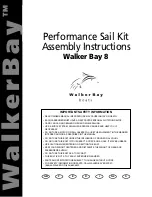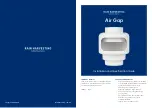
6
Fig. 1.5.c
1100
FLD
F
CB
Max sailspace FL
-(F+E)
E
Furlex type
204TD
304TD
Head deduction F
485 (19”)
Ø8: 490 (19”)
Ø10: 590 (23”)
Tack deduction E
(Any additional pendant to the
tack must be added to E)
75 (3”)
85 (3 5/16”)
Cutback CB
60 (2 1/2”)
60 (2 1/2”)
Internal diameter of luff groove DLG
Ø6 (15/64”)
Ø7 (9/32”)
Width of luff groove WLG
3.0 (1/8”)
3.0 (1/8”)
Overall luff extrusion dimensions
35x25
(1 3/8” x 63/64”)
42x31
(1 21/32” x 1 17/32”)
Your sailmaker has all the necessary sailmaker information through the Seldén Sailmakers Guide.
The Sailmakers Guide can be downloaded from www.seldenmast.com
Note that if you want to use an existing sail, it will need some modifications.
• The luff length needs to be adjusted.
• A luff tape is required. The luff tape must be compatible with the Furlex luff extrusion geometry.
• Use webbing loops at the sail head and tack instead of grommets (cringles). The sail will then form tightly
round the luff extrusion when furling, and achieve a better shape when reefed.
1.5 Sail measurements
Fig. 1.5.a
Fig. 1.5.b
It is most important that the halyard swivel is located so that the halyard satisfies the
10–15° angle requirement. If the sail prevents the swivel from reaching the correct
position, the luff length needs to be adjusted.
IF THE SAIL IS TOO LONG: Shorten the sail, e.g. in conjunction with changing to a
luff tape compatible with Furlex.
IF THE SAIL IS TOO SHORT: Lengthen the sail by means of a HMPE or wire
pendant fitted to the head of the sail. Attach the pendant directly to the sail to prevent
unintentional removal, loss or exchange.







































